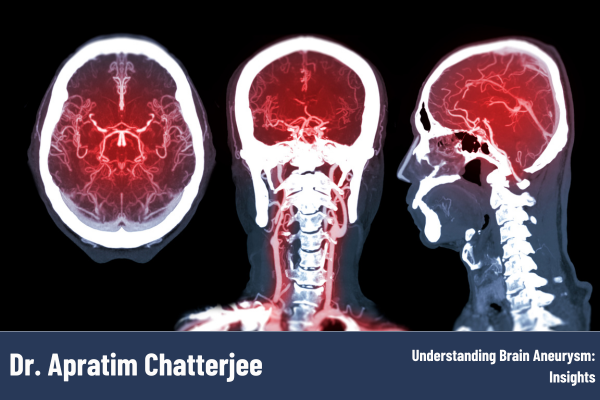A brain aneurysm is a serious medical condition that occurs when a weak spot in the wall of a brain artery balloons out, creating a bulge that can potentially burst and cause life-threatening bleeding. Dr. Apratim Chatterjee, one of Kolkata’s top interventional neurologists and stroke specialists, shares his expert insights on the causes, symptoms, and treatment options for brain aneurysms.
What is a Brain Aneurysm?
A brain aneurysm, also known as a cerebral aneurysm, develops when a blood vessel in the brain becomes weakened and inflates like a balloon. While some aneurysms remain stable and undetected, others may rupture, leading to a hemorrhagic stroke—a medical emergency requiring immediate attention.
Causes and Risk Factors
Dr. Chatterjee explains that several factors can contribute to the development of a brain aneurysm:
- Genetic Factors: Family history can play a role in the likelihood of developing aneurysms.
- Hypertension: Chronic high blood pressure can weaken blood vessels, increasing the risk of an aneurysm.
- Smoking: Tobacco use is a significant risk factor, as it can damage the blood vessel walls.
- Atherosclerosis: The buildup of plaque in the arteries can contribute to the formation of aneurysms.
- Age and Gender: Aneurysms are more common in individuals over 40 and are more frequently found in women.
Symptoms of a Brain Aneurysm
Brain aneurysms often remain asymptomatic until they become large or rupture. Dr. Chatterjee highlights key symptoms that may indicate the presence of an aneurysm:
- Severe Headache: Often described as the “worst headache of one’s life,” this can be a sign of a ruptured aneurysm.
- Visual Disturbances: Blurred or double vision can occur if the aneurysm is pressing on the optic nerve.
- Neck Pain: Stiff neck or pain can be associated with a leaking aneurysm.
- Nausea and Vomiting: These symptoms can accompany the sudden onset of a severe headache.
- Loss of Consciousness: A ruptured aneurysm may lead to a sudden loss of consciousness.
Diagnosis and Treatment
Detecting a brain aneurysm often involves imaging techniques such as CT scans, MRI, or cerebral angiography. Dr. Chatterjee emphasizes the importance of early detection and intervention:
- Monitoring: Small, unruptured aneurysms may be monitored over time with regular imaging studies.
- Surgical Clipping: This procedure involves placing a clip at the base of the aneurysm to prevent blood flow into the bulge, reducing the risk of rupture.
- Endovascular Coiling: A less invasive option where a catheter is used to fill the aneurysm with coils, preventing blood flow and reducing the risk of rupture.
- Flow Diversion: A newer technique involving a stent placed in the artery to divert blood flow away from the aneurysm, promoting healing of the vessel.
Preventing a Rupture
Preventing the rupture of an aneurysm is critical. Dr. Chatterjee advises managing risk factors such as hypertension and smoking. Regular check-ups and imaging studies for those with a family history of aneurysms are also recommended.
Conclusion
A brain aneurysm is a serious and potentially life-threatening condition that requires prompt medical attention. Dr. Apratim Chatterjee, a leading interventional neurologist and stroke specialist in Kolkata, offers expert care in diagnosing and treating brain aneurysms. If you or a loved one are at risk or experiencing symptoms related to a brain aneurysm, seeking immediate medical consultation is crucial. Dr. Chatterjee’s expertise in the field ensures that patients receive the best possible care and treatment for this complex condition.

